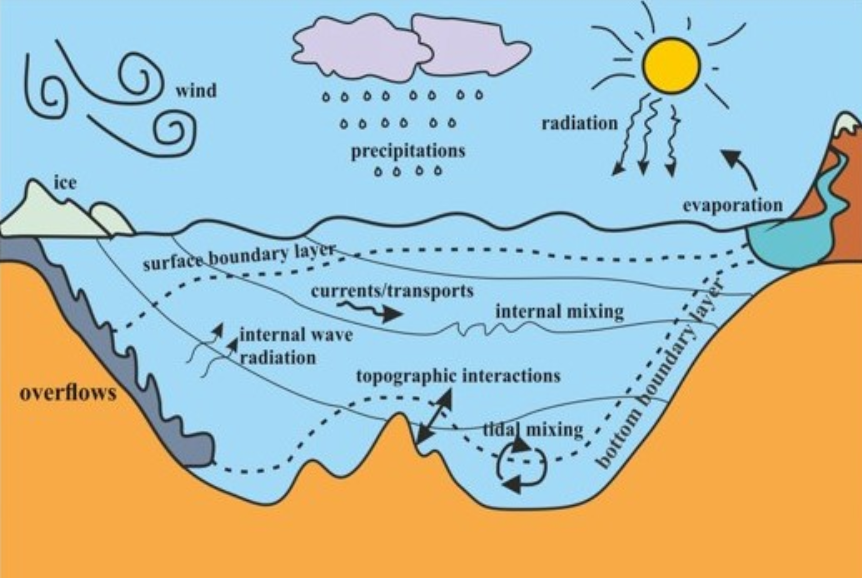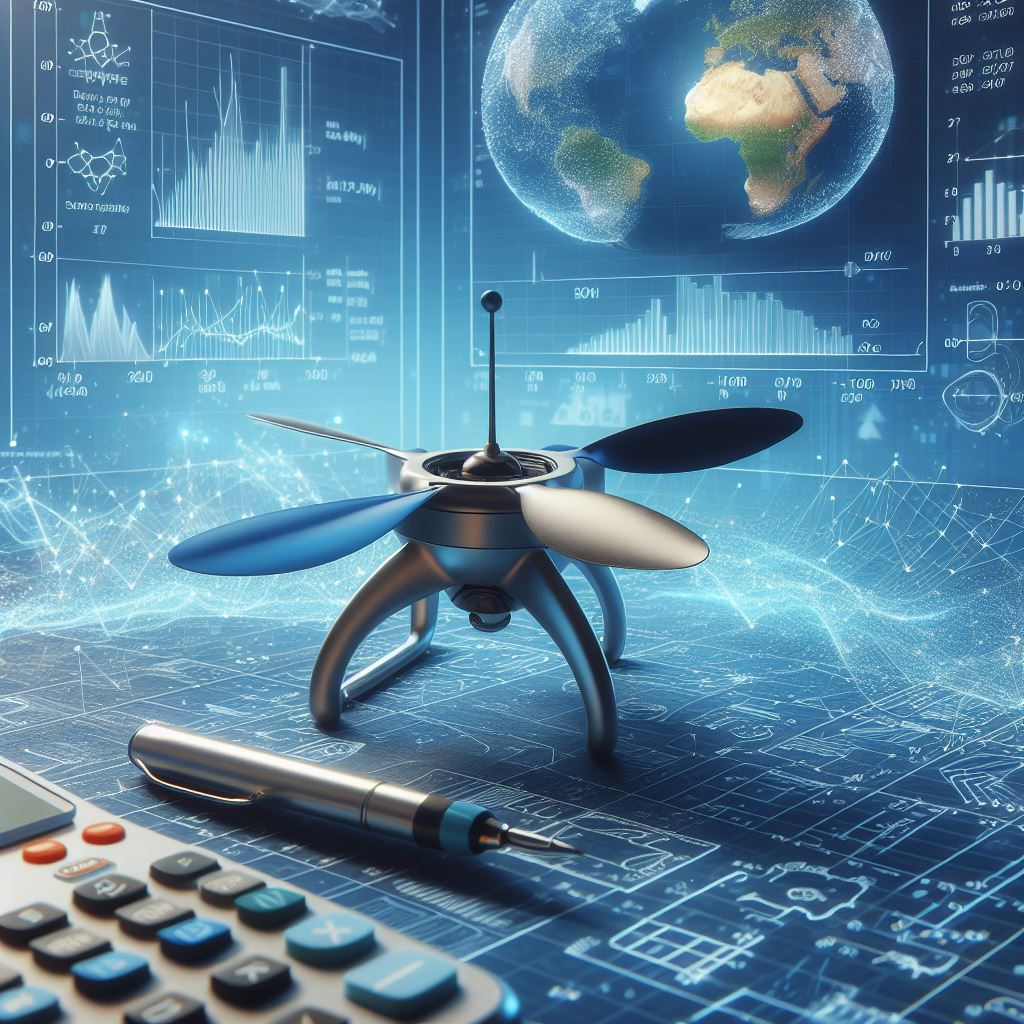Pinned
Geophysical flows refer to the motion and behavior of fluids, such as air and water, in the Earth’s atmosphere and oceans. These flows are influenced by gravity, Earth’s rotation, temperature differences, and pressure gradients, and they exhibit a wide range of complex and nonlinear behavior. Geophysical flows can occur over a wide range of scales, from microscopic to planetary, and can have important implications for the Earth’s climate and weather patterns.
Examples of geophysical flows include ocean currents and atmospheric circulation. Understanding these flows is essential for predicting and mitigating natural hazards such as hurricanes, as well as for understanding the long-term dynamics of the Earth's climate and environment.
 Petrola & Woods (2018)
Petrola & Woods (2018)
The study of geophysical flows involves the application of (i) mathematical models, (ii) observational data, and (iii) laboratory experiments to understand better the underlying physical processes that govern the behavior of fluids in the Earth system.
Geophysical Flows Lab, a Centre of Excellence at IIT Madras, is set up to make advances in the above three aspects with the vision of unlocking the mystery of Earth's cimalte mechanism.
Read full post
In August 2023, Chandrayaan-3’s Vikram lander touched down softly on the lunar surface, demonstrating its precise landing technology. As we continue to celebrate this triumph, it’s exciting to consider how emerging technologies might shape the future of landings - both in space and on Earth.
Whether it’s a lunar lander gracefully descending on the Moon’s surface, a Mars explorer touching down on the Red Planet, or a cutting-edge vertical takeoff and landing (VTOL) aircraft on Earth, the ability to land softly and safely is a complex yet crucial challenge.
Historically, liquid rocket engines have been the go-to for achieving VTOL capabilities in planetary vehicles, largely due to their ability to provide controllable thrust. However, VTOL applications on Earth necessitate a safer option. Enter hybrid rockets, which could prove to be a superior alternative for VTOL operations within Earth’s atmosphere and in space, offering advantages that extend well beyond just safety.
In another post, I had described my PhD student Anandu Bhadran’s work on establishing the thrust controllability of hybrid rocket motors. Leveraging on that, we embarked on a journey to show that hybrid rocket motors can be used for soft landings. Beyond simulations, we wanted to demonstrate soft landing using hybrid rocket motors. However, we did not have the bandwidth, in terms of time and resources, to develop a complete platform for this.
Hence, Anandu, along with Prof. Ramakrishna and I, delved into an innovative approach to this problem – we demonstrated the practical feasibility of using hybrid rocket thrusters in landing platforms with a technique called hardware-in-the-loop simulation (HILS). We reported our studies in the International Journal of Aeronautical and Space Sciences.
Read full post
Asteroids, those ancient wanderers of our solar system, have long captivated astronomers and space scientists. Of course, the asteroids hold the key to unravelling the mysteries of our cosmic origins. But beyond that, these celestial bodies present unique opportunities for space exploration, and they do have some rare elements we would like to mine and take.
When it comes to exploring asteroids, finding the right orbits for spacecraft is crucial. Periodic orbits around these celestial bodies are potential trajectories for space probes, mining facilities, and even deep space stations. A periodic orbit is a closed, repeating trajectory in the asteroid’s rotating reference frame – like satellite trajectories around Earth. A periodic orbit family is a group of related periodic orbits with similar characteristics, such as shape, but may differ in size.
While various periodic orbit families and their bifurcations around asteroids have been extensively studied, a specific type of bifurcation, known as period-multiplying bifurcations, has received less attention. In his research published in Aerospace, Rishi—my PhD student—focused on computing these elusive period-multiplying bifurcations of periodic orbit families around asteroids.
Read full post
Traditionally, microgravity research has been done in space stations or by dropping payloads from towers or balloons. These methods are great, but they can be expensive and have limited availability.
 In a previous post, I talked about Siddhardha’s thesis that multirotors can be turned into microgravity platforms.
In fact, he showed that every multirotor has the capability to be a microgravity platform.
Multirotor microgravity platforms provide scientists with an affordable way to conduct experiments under near weightlessness conditions.
But how do you choose the appropriate multirotor UAV for your microgravity experiment?
In a previous post, I talked about Siddhardha’s thesis that multirotors can be turned into microgravity platforms.
In fact, he showed that every multirotor has the capability to be a microgravity platform.
Multirotor microgravity platforms provide scientists with an affordable way to conduct experiments under near weightlessness conditions.
But how do you choose the appropriate multirotor UAV for your microgravity experiment?
In a recent work published in Microgravity Science and Technology, Siddhardha and I laid down a framework for assessing the microgravity-producing capabilities of a multirotor UAV.
Using our framework, you can estimate the g-time that a particular multirotor can provide while carrying the experimental setup of a specified weight.
Read full post
Solid rocket motors and liquid rocket engines are the two primary forms of rocket propulsion. For example, GSLV has its first stage as solid motor, and all of its other propulsion systems, including the strap-ons are liquid engines.
A solid rocket motor consists of a casing with a solid propellent (fuel-oxidizer mixer) that burns to produce thrust. Liquid rocket engines store fuel and oxidizer as liquids which are mixed and burned in a combustion chamber and exhausted through a nozzle to produce thrust. Solid rocket motors are simple to manufacture and operate, but once ignited, cannot be controlled or stopped. Liquid rocket engines are complex, but the thrust produced can be controlled (including a complete shutdown and restart).
Although developed as early as solid and liquid rocket motors, a rocket propulsion technology that did not quite catch up with the other two is hybrid rocket motor which typically has a solid fuel and liquid/gaseous oxidizer.
Recently, hybrid rocket motors have gained increasing interest due to their unique characteristics that offer improved safety and reduced costs compared to traditional solid and liquid rocket motors. As a result, hybrid rocket motors are an area of active research and development, with the potential to revolutionize the field of rocket propulsion.
Read full post
Propeller selection is a crucial stage in airplane design. A poor selection can result in an inefficient design.

Designers of small UAVs are often faced with a hurdle in the propeller selection stage in preliminary design due to the lack of simple yet accurate models to estimate small propellers’ performance (thrust coefficient, power coefficient, and efficiency at various combinations of forward speeds and propeller RPMs). It might even seem impossible to have accurate propeller performance models as the performance depends on the propeller geometry (airfoil characteristics, chord length, radius, and linear pitch). And small propellers have complex geometries, the details of which are proprietary and not publically available.
Nonetheless, we could still have accurate yet simple propeller models. That is what Siddhardha and I showed in our work published recently in Aerospace Systems.
Read full post

 Petrola & Woods (2018)
Petrola & Woods (2018) In a
In a 